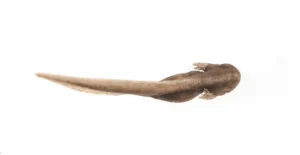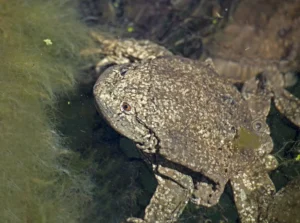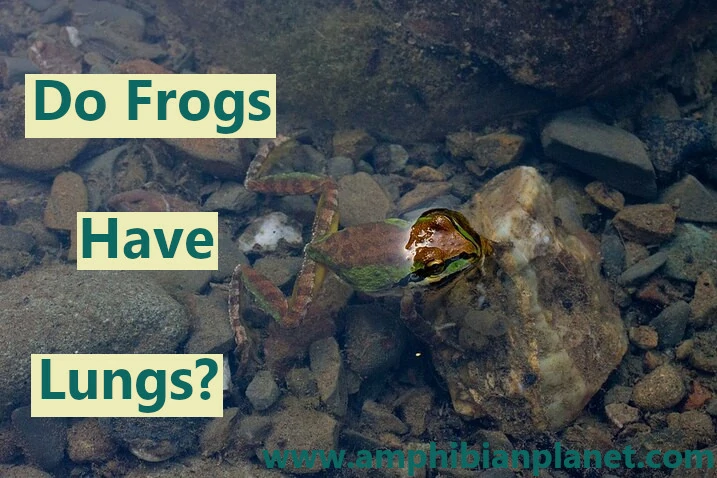Frogs are intriguing creatures that attract the curiosity of many people. There are also many misconceptions about these animals.
Most frog species have lungs which they use to breathe air. In addition to lungs, frogs also breathe through their skin and thin membranes in their mouth and throat. Only one out of more than 7,500 known frog species does not have any lungs.
Most frogs (not all), start their lives as fully aquatic tadpoles, with gills for breathing in the water. However, many tadpoles also have lungs which they use to breathe in addition to their gills.
Over time, the tadpoles will grow legs, lose their tails, and metamorph into adult frogs with well-developed lungs.
Tadpoles Breathe Through Their Gills
Tadpoles are very different from adult frogs; this is because they’re adapted for a fully aquatic life, while adult frogs are adapted for a semi-aquatic, or mostly terrestrial life (depending on the species).
External Gills
When first hatched, tadpoles have visible external gills, often in pairs, on either side of their heads. They use these gills to breathe in the water, just like fish.


The gills have thin membranes and a very large network of small blood vessels called capillaries. As water runs over the gills, the membranes absorb dissolved oxygen from the water and move it into the bloodstream.
The tadpole’s heart then pumps the oxygenated blood to distribute the oxygen throughout the body, just like in humans.
At the same time, waste carbon dioxide in the blood passes through the gills, and into the water.
Internal Gills
When tadpoles are in the middle stages of development (the time frame can vary depending on the species), opercular folds grow backward from the hyoid arch of each side covering the external gills and gill slits.

In this way, a gill cover known as an “operculum” is formed enclosing the external gills and gill slits – turning the external gills into internal gills. These internal gills are vented by ventrolateral openings, known as spiracles.
Depending on the species, there can be:
- Two spiracles on both sides of the body,
- A single spiracle on the underside near the vent, or
- A single spiracle on the left side of the body
Spiracles are tubular structures leading out of the opercular chamber. Tadpoles eject water through the nostrils and through the spiracles.
During metamorphosis, the gills are broken down, the lungs develop rapidly into the main organ of respiration.
Many Tadpoles Have Lungs, in Addition to Gills
It was previously believed that tadpoles lacked lungs throughout most of the larval period, relying on gills and cutaneous respiration for gas exchange until lungs and air breathing developed during metamorphosis in preparation for adult life.
However, with new scientific research, it is now widely known that the development of lungs in many tadpoles occurs well before metamorphosis.
A study of the tadpoles of five frog species representing three families found that they all began to inflate their lungs and breathe air within 3 or 4 days of hatching.
In addition, another study confirmed that Gray tree frog (Hyla versicolor) tadpoles develop lungs and begin breathing air within 3 days of hatching.
Air-breathing is essential for survival in water with low oxygen levels – where their gills (and skin) cannot absorb sufficient oxygen.
Many tadpoles experience hypoxic waters for some if not most of their lives. This problem is worsened by the fact that most frogs avoid laying eggs in open, more oxygenated waters due to the presence of predators such as fish and turtles.
A study found that African clawed frog (Xenopus laevis) tadpoles obtain 16.6% of their oxygen from air in normoxic water. However, this increases to 100% of net oxygen consumption in hypoxic water.
In addition, another study found that American bullfrog (Lithobates catesbeianus) tadpoles obtain 15% of their oxygen from air at the start of lung use, and 80% at the end of climax metamorphosis.
Other Tadpoles Only Develop Functional Lungs Further in Their Development
Although the tadpoles of many frog species start using lungs soon after hatching, it’s important to note that delay tadpoles’ lung inflation (meaning the initial act of inflating their lung rudiments with air) to different stages after hatching – depending on the species.
Not all tadpoles breathe using their lungs shortly after hatching.
For example, the tadpoles American bullfrogs (Lithobates catesbeianus) do not inflate their lungs until mid-tadpole stages. Before the start of lung use, the tadpoles strictly breathe using their gills, and skin.
Other tadpoles such as those of the coastal tailed frog (Ascaphus truei), Lace-eyed Tree Frog (Litoria dayi), Goose frogs (Megophryidae), European spadefoot toads (Pelobatidae), North American spadefoot toads (Scaphiopus), and bufonid toads – delay lung inflation until metamorphosis.
Tadpoles Turn Into Frogs
After a few months to a few years (depending on the species) the tadpoles will go through a process known as metamorphosis, in which they will transform into juvenile frogs.

This hormone triggers the tadpoles to:
- Absorb the tail into the body
- Grow strong legs for moving on land
- Remodel other organs to form an adult frog
During metamorphosis, tadpoles will also gradually lose their gills. While the gills are being broken down, the lungs develop rapidly into the main organ of respiration.
Once metamorphosis fully is complete, the tadpoles will be young frogs and will leave the water to live on land. These young frogs will grow and mature into adults over time.
Adult Frogs Have Lungs
Once the metamorphosis from tadpole to frog is complete – frogs have functional, well-developed lungs that they use to breathe air. They take air through their nostrils, and down into their lungs.
That said, it’s important to note that amphibian lungs are quite primitive when compared to our own.
Frogs do not have diaphragms to push air into the lungs as we do. Instead, they rely on a process known as “buccal pumping.”
Buccal Pumping is basically a process of moving air in and out of the lungs through the use of the mouth and throat muscles.

To breathe in, the frog will lower the floor of its mouth, which causes the throat to expand. Air then rushes into the throat, through the mouth, and through the open nostrils.
The frog will then close its nostrils, and raise the floor of its mouth, which causes the throat to contract, and pushes the air into the lungs.
Once the air is in the lungs, oxygen from the air is then absorbed into the frogs’ bloodstream. At the same time, carbon dioxide from the bloodstream is diffused into the air.
To breathe out, the frog will lower the floor of its mouth, which causes the throat to expand and draws the air from the lungs, and into the mouth. It will then open its nostrils, and raise the floor of its mouth, to push the air out of the nostrils.
Frogs Also Breathe Through Their Skin
Lungs alone usually can not give a frog all the oxygen it needs. For this reason, frogs can also breathe through their skin and thin membranes in their mouth and throat to get extra oxygen, in a process known as cutaneous respiration.
The skin is made up of thin membranous tissue that is highly permeable to water and contains a large network of capillaries and other blood vessels close to the surface.
The thin membranous skin allows oxygen from the air to be absorbed into the bloodstream via diffusion. At the same time, carbon dioxide from the bloodstream passes through the skin and membranes and is diffused into the air.
To efficiently breathe, frogs have to keep their skin constantly moist by secreting a mucous coating. They can only absorb oxygen through their skin if the skin stays moist. If it dries up, they can suffocate and die.
Some Frogs Have Reduced Lungs
In some frog species, cutaneous respiration is so efficient that it is their main way of breathing. For example, the Titicaca water frog (Telmatobius culeus) is an aquatic frog species with wrinkled skin.
This frog’s excessive amount of skin makes it look rather as if it were wearing an oversized wet suit. But it performs a very important function– it provides a bigger surface area to use for cutaneous respiration.
For this reason, Titicaca water frogs have greatly reduced lungs – less than one-third the size that would be expected of other frog species of the same body size.

Because of their large skin surface area, these frogs mainly breathe through their skin, and only occasionally use their lungs. In fact, they can go for several days without using their lungs.
The Frog Without Lungs
The endangered Bornean Flat-Headed frog (Barbourula kalimantanensis) found in Indonesia is currently the only known species of frog that does not have any lungs at all! It breathes entirely via its skin, just like many lungless salamanders.

This aquatic frog lives in cold, fast-moving rivers that provide a rich supply of oxygen and most likely lower the frog’s metabolic rate. So to the frog, oxygen is in high supply and low demand.
Its stomach, spleen, and liver take up much of the space which normally would be filled by the lungs. Due to a lack of lungs, the Bornean Flat-Headed frog is flatter than typical frogs.
The flattened body and head (which gives this frog its name) give its skin a large surface area for absorbing oxygen from the surrounding water. It may also enable to frog to avoid being swept away in fast streams.
Sources:
Scott Pronych and Richard Wassersug. 2011. Lung use and development in Xenopus laevis tadpoles. Canadian Journal of Zoology. 72(4): 738-743. https://doi.org/10.1139/z94-099
Jackson R. Phillips, Amanda E. Hewes, Kurt Schwenk; The mechanics of air breathing in gray tree frog tadpoles, Hyla versicolor (Anura: Hylidae). J Exp Biol 1 March 2020; 223 (5): jeb219311. doi: https://doi.org/10.1242/jeb.219311
Christopher S. Rose, Brandon James; Plasticity of lung development in the amphibian, Xenopus laevis. Biol Open 15 December 2013; 2 (12): 1324–1335. doi: https://doi.org/10.1242/bio.20133772
Warren W. Burggren, Nigel H. West, Changing respiratory importance of gills, lungs and skin during metamorphosis in the bullfrog rana catesbeiana, Respiration Physiology, Volume 47, Issue 2, 1982, Pages 151-164, ISSN 0034-5687, https://doi.org/10.1016/0034-5687(82)90108-6.
Jackson R Phillips, Jens Reissig & Gary Kyle Nicolau (2023) Notes on lung development in South African ghost frogs (Anura: Heleophrynidae), African Journal of Herpetology, 72:1, 81-90, DOI: 10.1080/21564574.2023.2191602


